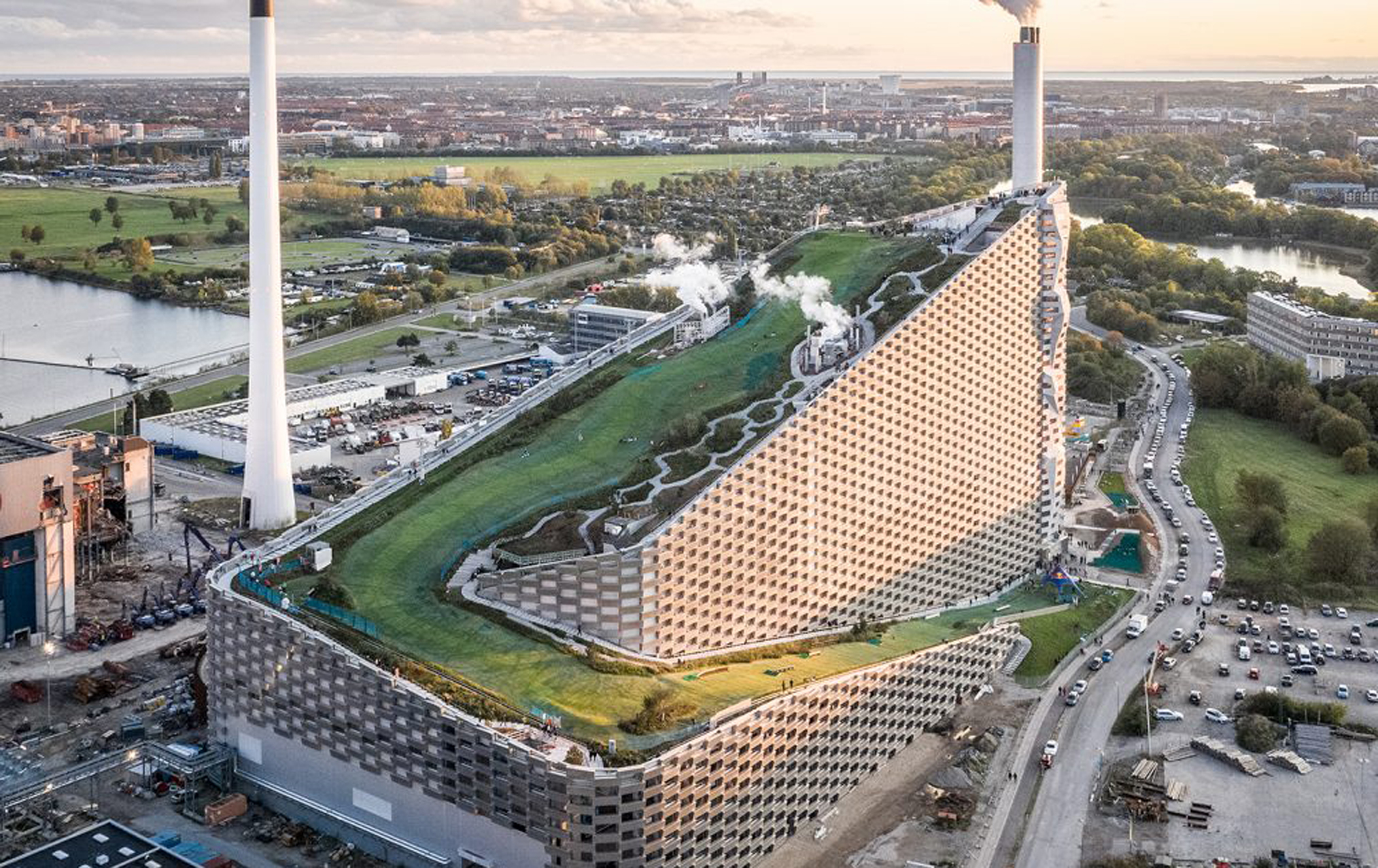
“Our goal was to redefine what a waste-to-energy plant could be,” says Jacob Simonsen, CEO of ARC, the company that operates Copenhill. “We wanted to show that sustainability and urban living are not mutually exclusive and can even be fun.”
Copenhill, officially known as Amager Bakke, is not your typical waste-to-energy plant. The towering structure located just outside central Copenhagen not only processes 440,000 tons of waste annually but also serves as a playground for adventure-seekers. Topped with a 400-meter synthetic ski slope, hiking trails, and the world’s tallest artificial climbing wall, the facility is a pioneering fusion of infrastructure, sustainability, and recreation.
Designed by the renowned Bjarke Ingels Group (BIG), Copenhill is part of Denmark’s larger effort to become the world’s first carbon-neutral capital by 2025. The plant is a striking example of how energy infrastructure can be transformed into a multi-functional, public space—serving the dual purpose of generating power while providing an active, recreational environment for city residents.
“At Copenhill, we wanted to challenge the traditional idea that power plants must be tucked away out of sight. We’ve shown that they can actually enhance urban life,” says Bjarke Ingels, founder and creative director of BIG. “Our ambition was to create a new kind of city park—one that isn’t just green in appearance, but green in function.”
Rethinking Energy Infrastructure
At its core, Copenhill is a fully operational waste-to-energy facility. The plant uses incineration to convert non-recyclable waste into electricity and heat for more than 150,000 homes across Copenhagen. This process reduces landfill reliance and cuts down on carbon emissions, making the plant a vital component of the city’s waste management and energy strategy.
While other cities grapple with the environmental challenges posed by landfills and fossil fuel-based energy production, Copenhagen is embracing waste-to-energy technology as part of its clean energy portfolio. Copenhill’s advanced flue gas cleaning system captures more than 99% of harmful particles, ensuring minimal emissions while generating energy.
Simonsen underscores the plant’s role in the city’s green energy goals: “Copenhill isn’t just about waste management. It’s about turning a necessary utility into a forward-thinking environmental solution. It’s a vital step toward carbon neutrality for Copenhagen.”
What sets Copenhill apart from other energy facilities, however, is its integration into the urban landscape and its use as a public amenity. Rather than hide the plant behind industrial fences or keep it out of sight in a remote area, ARC and BIG envisioned Copenhill as an open, inviting part of the community—one that not only helps power the city but also becomes a hub for recreation and social activity.
“We see this as a new paradigm for what power plants can be,” says Ingels. “Infrastructure can be beautiful, useful, and even playful. Copenhill is proof of that.”
From Power Plant to Playground
Copenhill’s design challenges conventional notions of infrastructure. Rising 85 meters (279 feet) above the ground, the facility is topped by a synthetic ski slope, made from Neveplast, a material that mimics the sensation of skiing on snow. Open year-round, the slope offers locals and visitors a place to ski or snowboard in the heart of the city—an unusual activity in a country without mountains.
For those less inclined to ski, Copenhill’s roof also features hiking trails, which wind through pockets of greenery planted to resemble a mountainous landscape. A glass-walled elevator takes visitors to the top of the plant, offering panoramic views of the Copenhagen skyline and beyond. At the base of the structure, the world’s tallest artificial climbing wall offers thrill-seekers a unique challenge—scaling the very walls of an operational power plant.
“The idea of putting a ski slope on a waste-to-energy plant might seem far-fetched, but it’s an opportunity to showcase what’s possible when we think creatively about infrastructure,” says Simonsen. “We’ve redefined what a power plant can be for its city.”
The project isn’t just about entertainment. Copenhill has become a symbol of Copenhagen’s commitment to sustainability and green living. The plant’s roof is also home to one of the city’s largest green spaces, a man-made hill designed to manage stormwater runoff and provide a habitat for local flora. The rooftop park serves as both a functional green space and a statement piece, inviting residents to engage with the plant while enjoying nature.
Sustainability as a Way of Life
Denmark’s focus on sustainability is no secret, and Copenhill reflects that ethos. The facility’s waste-to-energy process turns household waste into both electricity and heat, and its flue gas cleaning system captures sulfur dioxide, nitrogen oxides, and dioxins before they can be released into the air. As a result, Copenhill is one of the cleanest waste-to-energy plants in the world.
“We’re proud to say that Copenhill is not only an adventure park but also one of the most environmentally friendly waste-to-energy plants ever built,” says Simonsen. “It demonstrates that urban infrastructure can serve multiple purposes—both functional and recreational—while maintaining a low environmental impact.”
This sustainability extends to the plant’s long-term vision as well. Copenhagen aims to be carbon neutral by 2025, and Copenhill plays a significant role in that effort. By turning waste into clean energy, the plant helps the city offset the need for fossil fuels and reduces the amount of waste sent to landfills. In addition, the plant’s innovative flue gas cleaning system captures and stores CO2, further lowering its environmental footprint.
“We see Copenhill as a key piece of the puzzle in helping Copenhagen meet its climate goals,” says Simonsen. “It’s a project that embodies both the ambition and the innovation that are central to our city’s future.”
A Model for Future Infrastructure
Copenhill’s unique combination of energy infrastructure, sustainability, and adventure tourism is already inspiring other cities around the world. As global urban populations grow and the demand for sustainable energy solutions increases, waste-to-energy plants like Copenhill offer a promising model for future infrastructure projects.
Ingels believes Copenhill is a glimpse into what the future of urban infrastructure might look like. “This project shows that infrastructure doesn’t need to be hidden away,” he says. “It can be integrated into the city and made accessible to everyone. It can be both beautiful and functional.”
As cities look to balance energy needs with sustainability goals and quality of life, projects like Copenhill offer a blueprint for how to rethink infrastructure. By transforming a necessary piece of energy infrastructure into a public asset, Copenhagen has created something truly unique: a place where waste becomes energy, and energy becomes a source of community and adventure.
“In the end,” says Simonsen, “Copenhill isn’t just about powering homes. It’s about powering people’s imaginations about what a sustainable future can look like.”













